"Flying Dutchman" - Ghost Ship - OREL Russian Paper Model Build
- Thread starter mtrappett
- Start date
You are using an out of date browser. It may not display this or other websites correctly.
You should upgrade or use an alternative browser.
You should upgrade or use an alternative browser.
yeah, they are pretty nice blocks. They are supposed to be walnut hardwood. They have a thin groove around the body of them for the rigging twine. They are too small for a real pulley / sheave so they have just a hole that runs through them. I had to run the drill through them to get rid of a little restriction for thread to go through.Wow!! Real blocks. I have some wooden blocks with Brass pulleys from a 150 year old sailing ship I salvaged. I took many Bronze parts off of that ship, like pulleys, braided steel lines to wooden pulleys, one with a oval hoop, on the end of a three foot steel cable, that someone did with a Marlin Spike, then leaded. I've never seen anything like it, and the parts for a Fo'c'sle that wood was rotted on, but the Bronze fittings had a perfect patina on them. My wife asked what I was going to do with it, I told her "I don't know, but you just can't get castings like that anywhere". I would donate it to the right person making a sailboat.
You use your electric drill like a small lathe, very cool!!
My ZZR1200 is quite a ridiculous motorcycle. New Pirelli's on it. I am putting a set of NISSIN ZX9R calipers to the front, far superior brakes. It does 80 mph in first gear, and it's a six speed. I knocked about 45 lbs. of weight modifying the bike, so now it doesn't weight too much more the my GS750ES, which is one of the finest handling bikes, almost a bit too fine, with the 16" front wheel, it seems to anticipate what you're going to do, but gets you out of trouble just as fast as you got yourself into it. I purchased that new in 1983.
Wow! 80 mph in first gear! That is awesome! 45 lbs. is quite a large chunk of weight to have shed off that! The lighter it is, the faster the acceleration and braking of course, which is just what the doctor ordered!
 I love Pirelli tires! I have them on my car, and its kind of makes me think of some kind of assurance against problems from what I have found over the years I've had it. My old car is 30 years old, next year.
I love Pirelli tires! I have them on my car, and its kind of makes me think of some kind of assurance against problems from what I have found over the years I've had it. My old car is 30 years old, next year.Much appreciated sirIts still amazing all the details and craftmanship you put in your model.

Continuing on with the mast and yards.
These are the parts that make up the foremast structure. The masts on the left and the yards on the right.
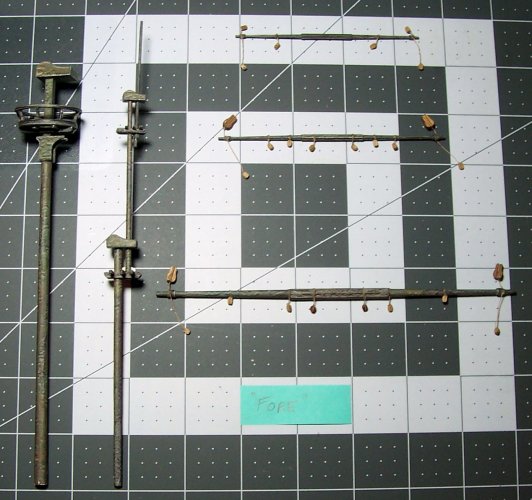
The mainmast and associated yards.
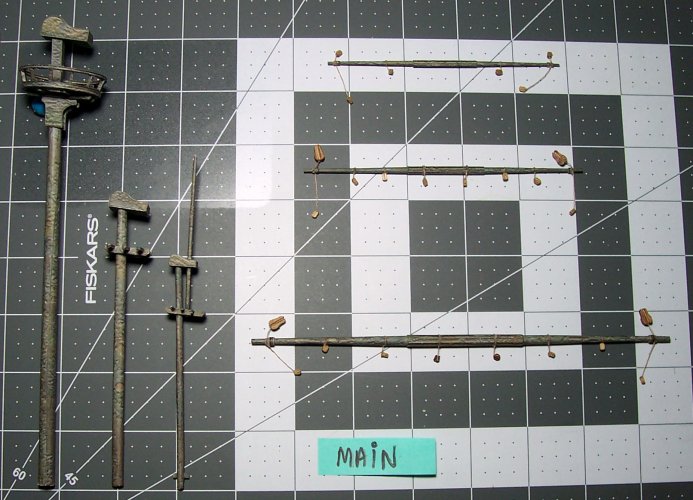
And the mizzen and all its pieces.
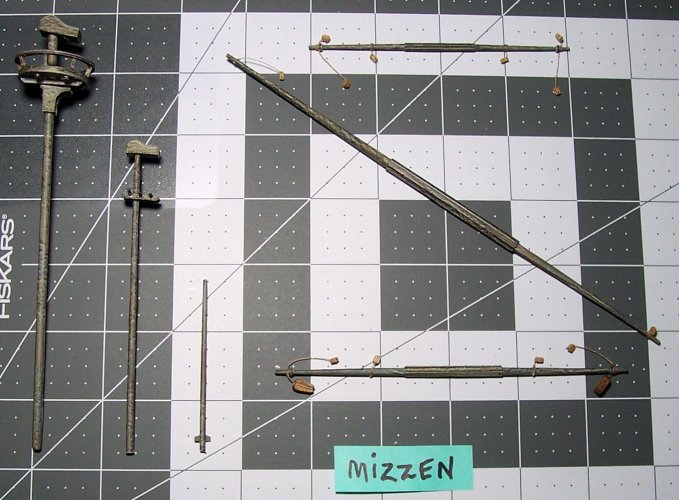
There are so many separate pieces, I found it essential to organize them all into marked Ziploc bags. It would be so easy to use the wrong part(s)

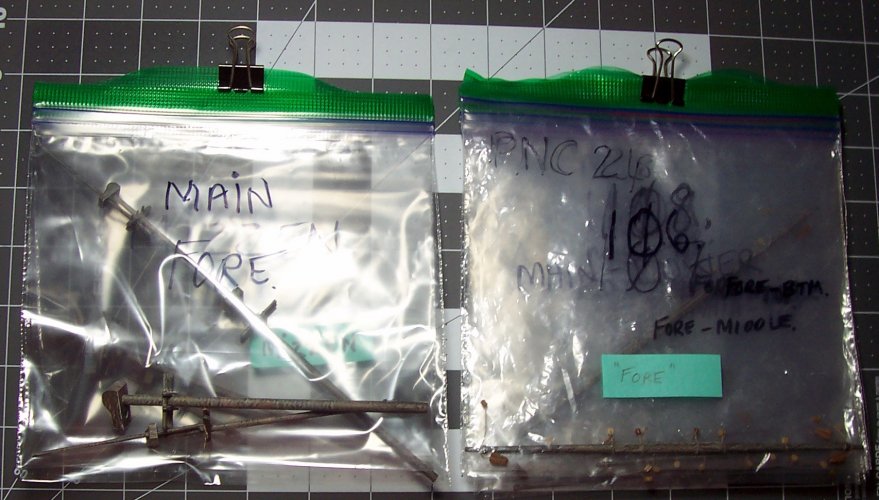
I noticed after reading up on tall ships, that all had "wooldings" on the lower main and foremast. These were used to strengthen the masts against damage at sea. There were never any on the mizzen though. It seemed to me to be a mistake not to add them as they can even be seen on the real Flying Dutchman ship, plus all Dutch ships of the times.
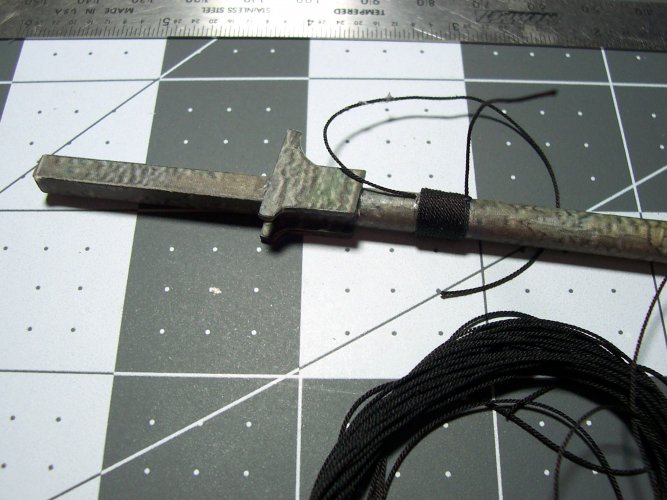
I found that 0.45 mm dark brown looks about the right scale, and color. They said they used about 8 turns around the mast. Dutch ships usually had less wooldings than English ships which usually had many more than 5 wooldings.
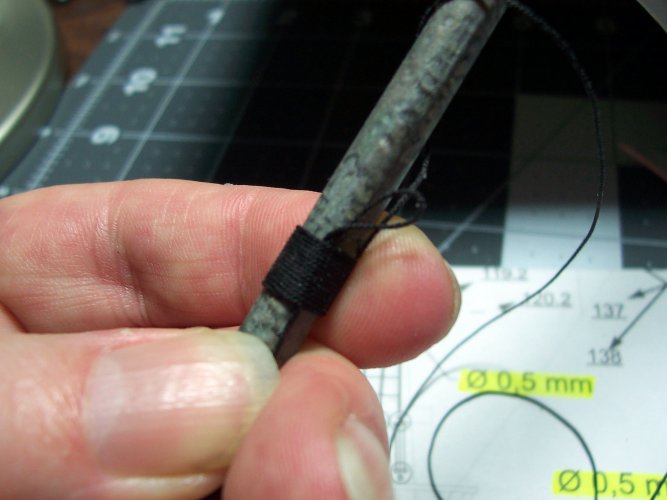
They are basically done the same way as on a real ship.
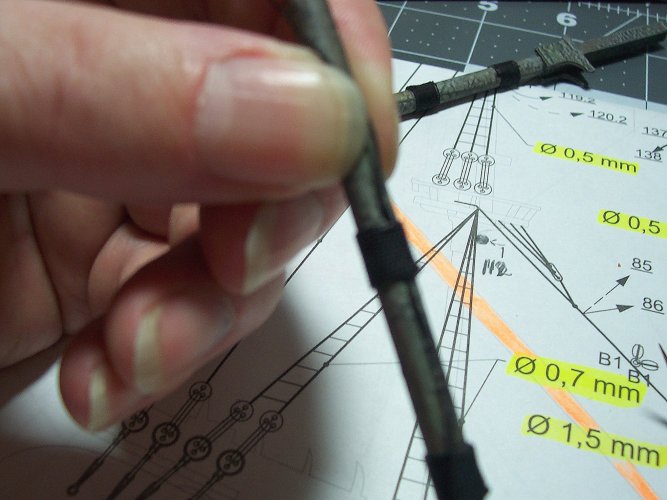
All done. The woolding on the far right blow was just an experiment to see how they would look.
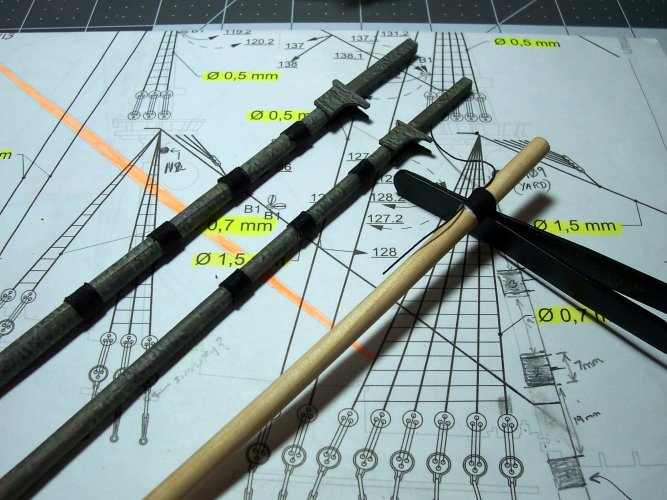
These are tiny eyelets for various places on the ship.
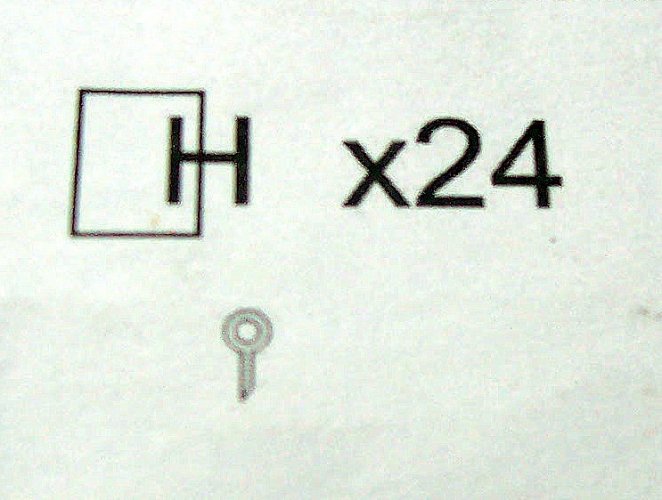
A few items that I needed to make the custom metal fittings for the ship. The wire on the left is used for jewelry making purposes, and is tin plated copper so is very soft and malleable. On the top is piano / music wire, and on the right, ferrous garden wire.
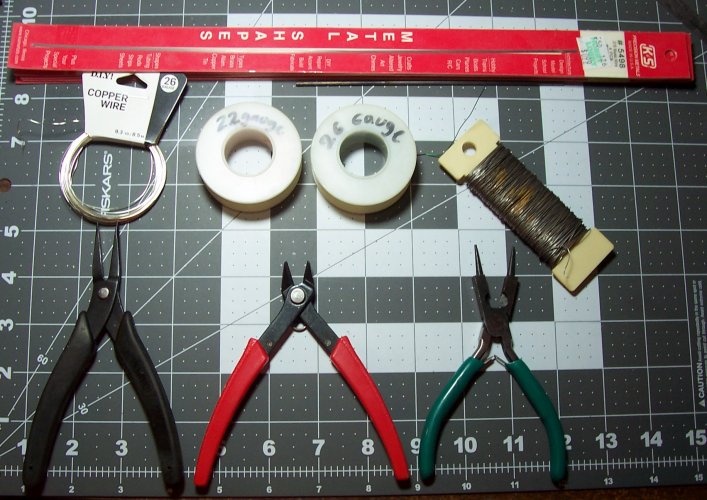
I put a pin in the vice, and bent the wire into a loop around it.
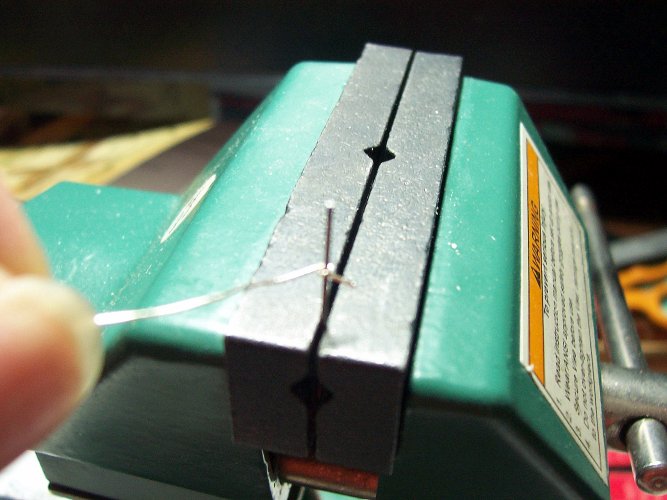
Not bad! This is the 'shiny' version, actually a bit too shiny for me
This is the 'shiny' version, actually a bit too shiny for me 
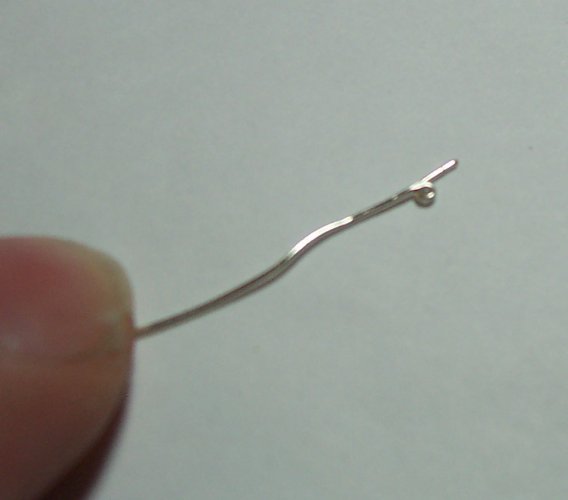
Next, the eyebolt links for the shrouds. These are the middle links.
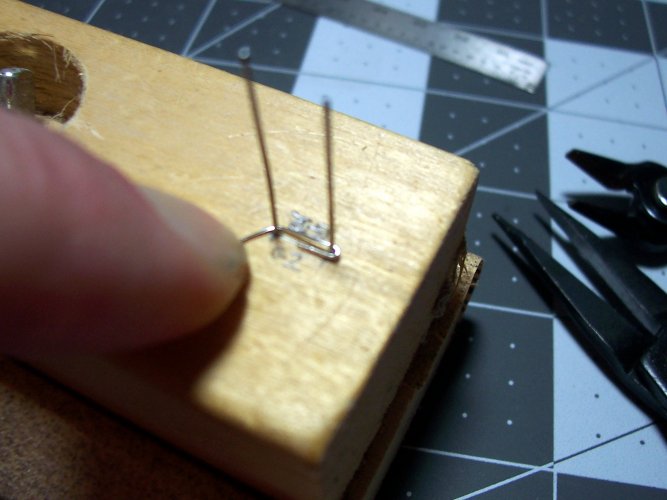
The pins are spaced accordingly from the plans. There are 2 main sizes to make labeled, G1 and G2.
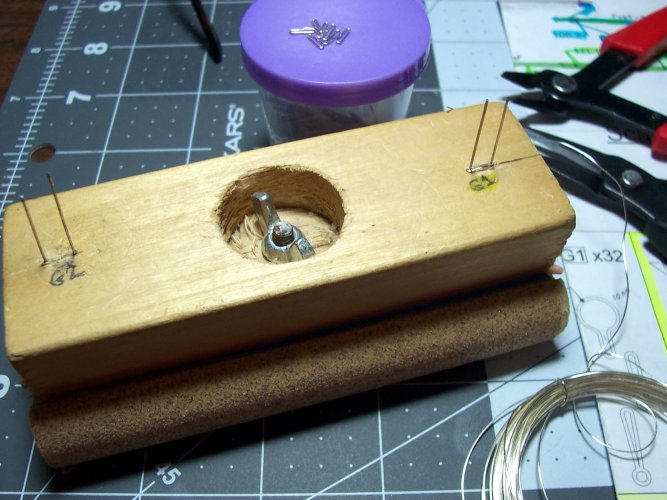
32 of these assemblies needed. That is 3 X 32 = 96 metal parts. That a LOT of bending
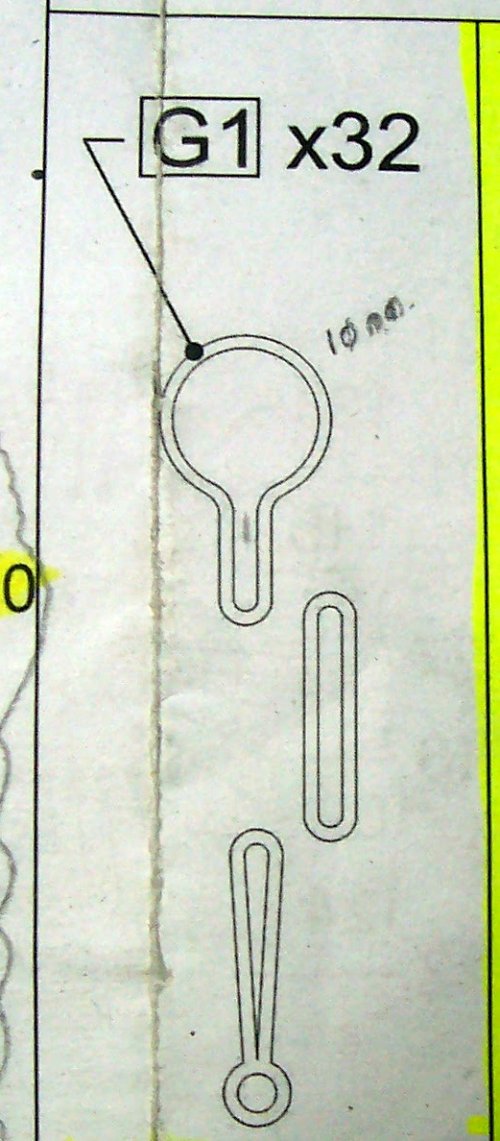
And 14 of these slightly smaller versions. That another 3 X 14 = 42 parts in all.
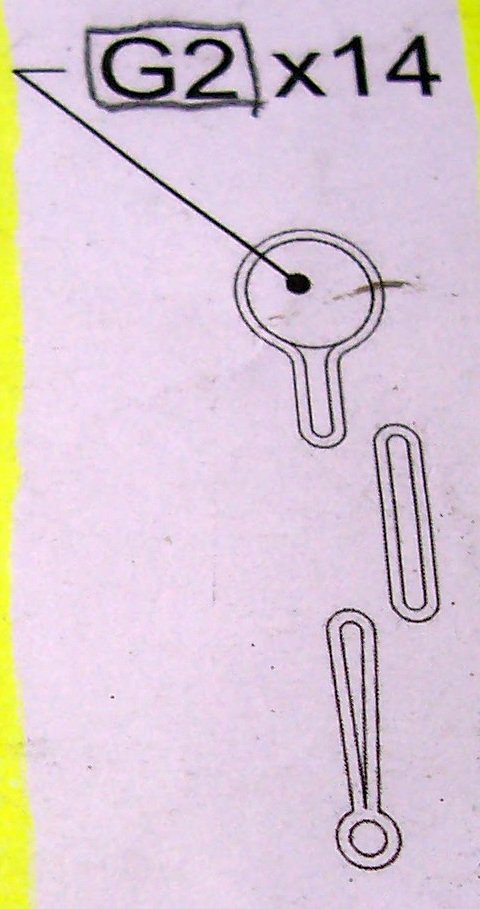
After taking a look of all the finished pieces, I made the decision to scrap them all, and make them from the 26 gauge garden wire. They look much better and not so shiny right out of the gate. These first batches I made, I just put down to practice making the parts Below are the steel wire versions soaking in a little acetone to get rid of any grease and stuff.
Below are the steel wire versions soaking in a little acetone to get rid of any grease and stuff.
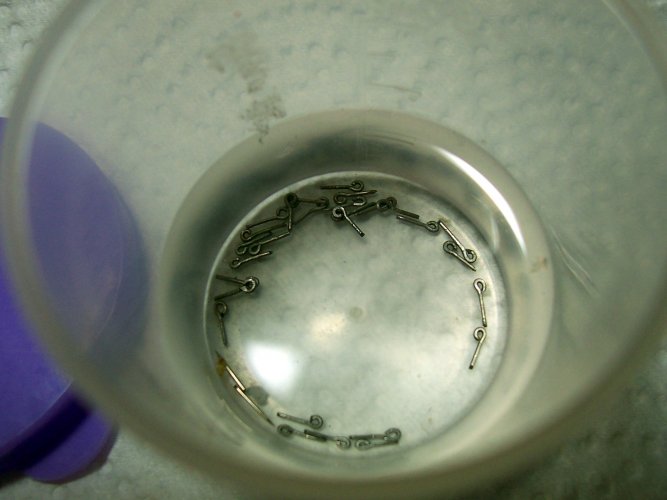
Next, after drying them off, is to place them in the black patina acid. It takes only a couple of minutes to make them go black.

This is the black patina used for the job. You have to use care for this stuff and read the instructions well.
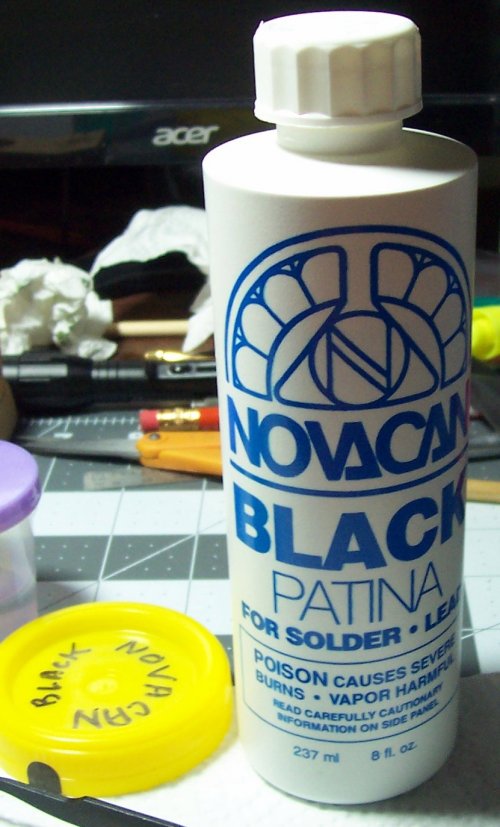
I Pulled them from the acid, and put them into water to neutralize the acid. Then, placed them on a paper towel to dry off. You don't have to do this of course. You could leave them regular metal finish, but I wanted a black patina on most of the metal fittings as a standard. By the way, this is not the same as just painting with matt black.
Its interesting that building model ships leads us into new areas like this. In this case. we have experiences with chemicals.
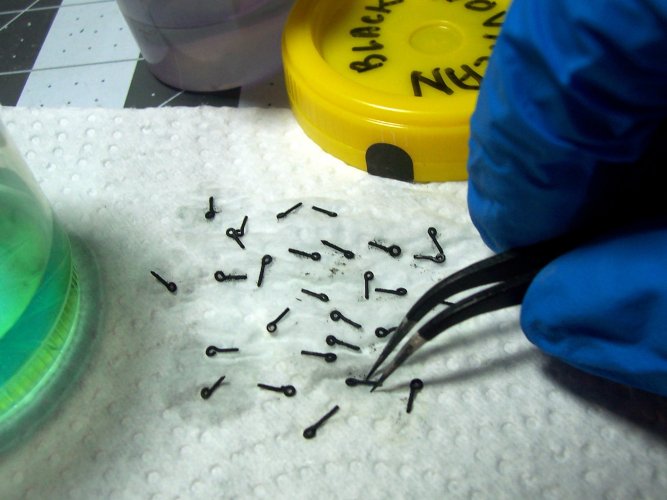
These are the parts that make up the foremast structure. The masts on the left and the yards on the right.

The mainmast and associated yards.

And the mizzen and all its pieces.

There are so many separate pieces, I found it essential to organize them all into marked Ziploc bags. It would be so easy to use the wrong part(s)



I noticed after reading up on tall ships, that all had "wooldings" on the lower main and foremast. These were used to strengthen the masts against damage at sea. There were never any on the mizzen though. It seemed to me to be a mistake not to add them as they can even be seen on the real Flying Dutchman ship, plus all Dutch ships of the times.

I found that 0.45 mm dark brown looks about the right scale, and color. They said they used about 8 turns around the mast. Dutch ships usually had less wooldings than English ships which usually had many more than 5 wooldings.

They are basically done the same way as on a real ship.

All done. The woolding on the far right blow was just an experiment to see how they would look.

These are tiny eyelets for various places on the ship.

A few items that I needed to make the custom metal fittings for the ship. The wire on the left is used for jewelry making purposes, and is tin plated copper so is very soft and malleable. On the top is piano / music wire, and on the right, ferrous garden wire.

I put a pin in the vice, and bent the wire into a loop around it.

Not bad!
 This is the 'shiny' version, actually a bit too shiny for me
This is the 'shiny' version, actually a bit too shiny for me 
Next, the eyebolt links for the shrouds. These are the middle links.

The pins are spaced accordingly from the plans. There are 2 main sizes to make labeled, G1 and G2.

32 of these assemblies needed. That is 3 X 32 = 96 metal parts. That a LOT of bending


And 14 of these slightly smaller versions. That another 3 X 14 = 42 parts in all.

After taking a look of all the finished pieces, I made the decision to scrap them all, and make them from the 26 gauge garden wire. They look much better and not so shiny right out of the gate. These first batches I made, I just put down to practice making the parts
 Below are the steel wire versions soaking in a little acetone to get rid of any grease and stuff.
Below are the steel wire versions soaking in a little acetone to get rid of any grease and stuff.
Next, after drying them off, is to place them in the black patina acid. It takes only a couple of minutes to make them go black.

This is the black patina used for the job. You have to use care for this stuff and read the instructions well.

I Pulled them from the acid, and put them into water to neutralize the acid. Then, placed them on a paper towel to dry off. You don't have to do this of course. You could leave them regular metal finish, but I wanted a black patina on most of the metal fittings as a standard. By the way, this is not the same as just painting with matt black.
Its interesting that building model ships leads us into new areas like this. In this case. we have experiences with chemicals.


Amazing work. You can tell that this work is loved.
- Apr 5, 2013
- 13,876
- 10,215
- 228
From the scale rope, to a Bird's Nest that I'd climb on, there's just too much to say that is right. Fantastic job. It will need a plastic case, or upside down aquarium, to keep it safe, and keep the dust off of her. She's going to be quite a beauty to behold. The Patina you applied, well, that is just amazing! 
Thanks Micah! I think it's become an obsession!Amazing work. You can tell that this work is loved.
Thank you for all the kind words Zathros!From the scale rope, to a Bird's Nest that I'd climb on, there's just too much to say that is right. Fantastic job. It will need a plastic case, or upside down aquarium, to keep it safe, and keep the dust off of her. She's going to be quite a beauty to behold. The Patina you applied, well, that is just amazing!
I was looking at the price of some of those cases, and wow! They are expensive, but I would like one one day in the future.
That black patina finish does work really good. It works best on anything that is attracted by a magnet. Any ferrous metals, solder, lead, and brass too

Thank you for the nice commentsAmazing how you have made these metal partx. I love it.
I have learned a great deal from building this model, and of tall ships in general. I honestly didn't realize before that I would be using different size "ropes" for the rigging. Also several different sizes of dead-eyes, and types of blocks/pulleys and so on.
Thank you for your comments Rhaven!The amount of detail and work that you are putting into this project is mind blowing! The rigging looks AMAZING!!!
Metal Fittings Creation - Continued
It makes the job easier to use some flux for the solder so that it mainly targets the area you need. I use a darning needle on a stick to apply it to the links.
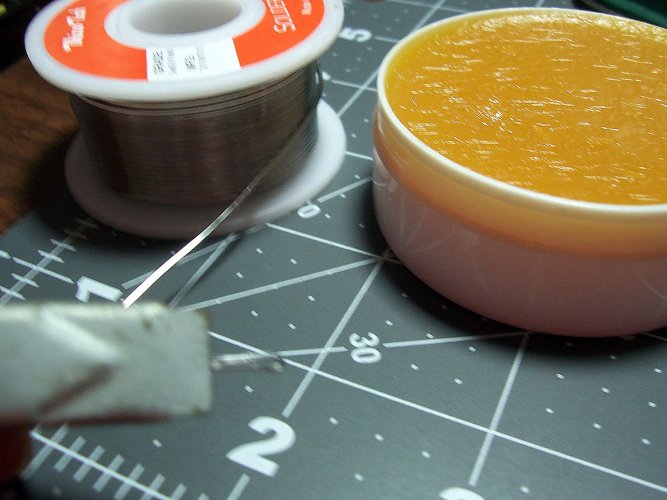
A temperature controlled soldering iron works pretty good. Just go very easy on the solder to avoid flooding the part.
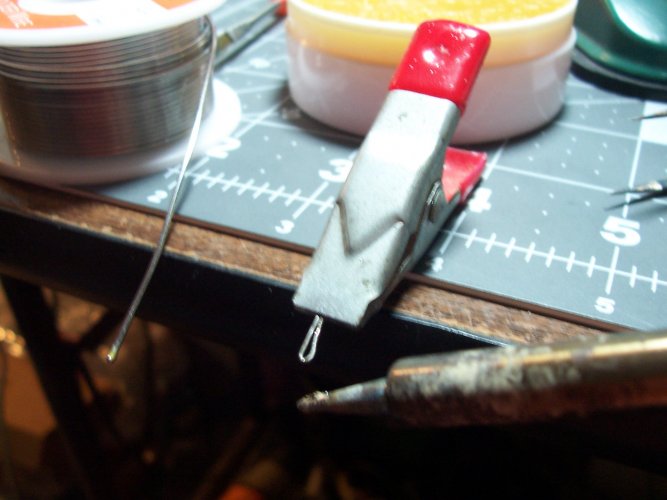
These are the strops for fitting the deadeyes to the ship. The photo-etch makes them a perfect solution. I got the 5mm and 4mm versions.
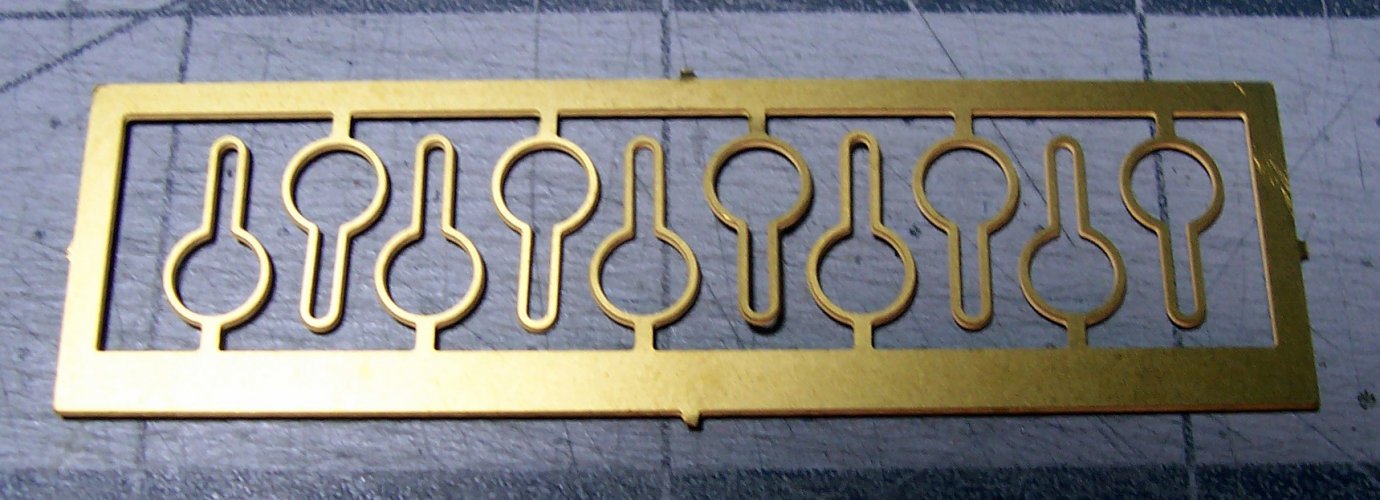
Here's one of the 5mm walnut deadeyes next to the strops that will eventually hold them in place on the channels under the shrouds.
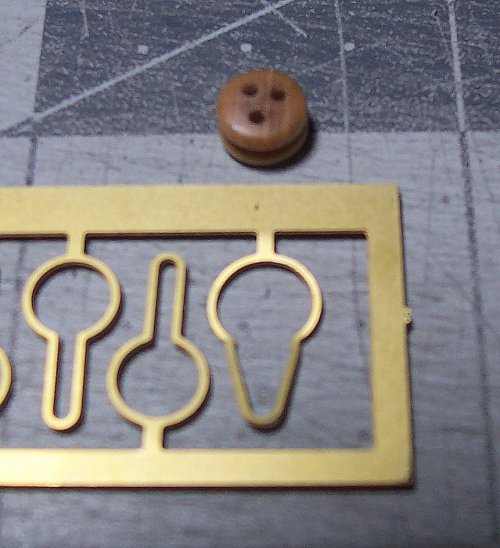
Just tweak the strop a little to get it to fit onto the deadeye. Then, squeeze the sides of the base of the strop to capture the deadeye. Make sure to orient the deadeye correctly!
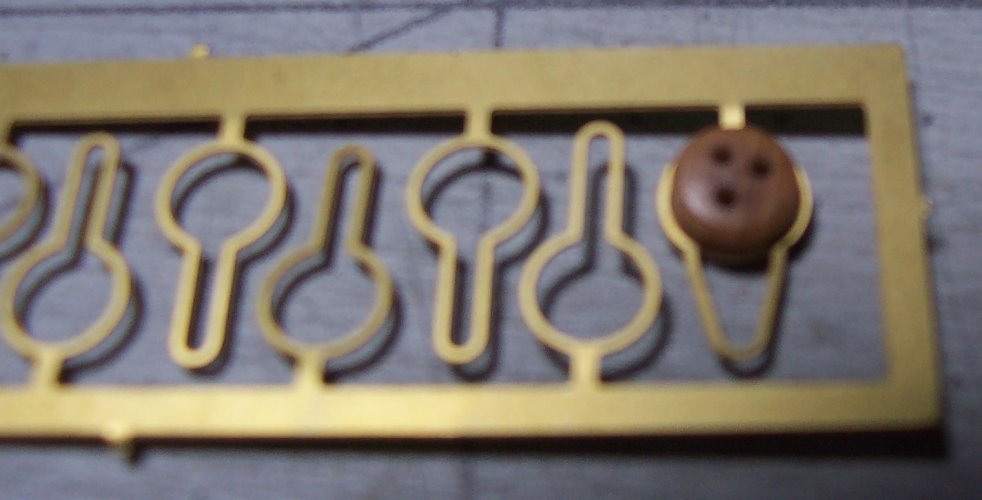
I gave the strops and the links I made the black patina treatment.
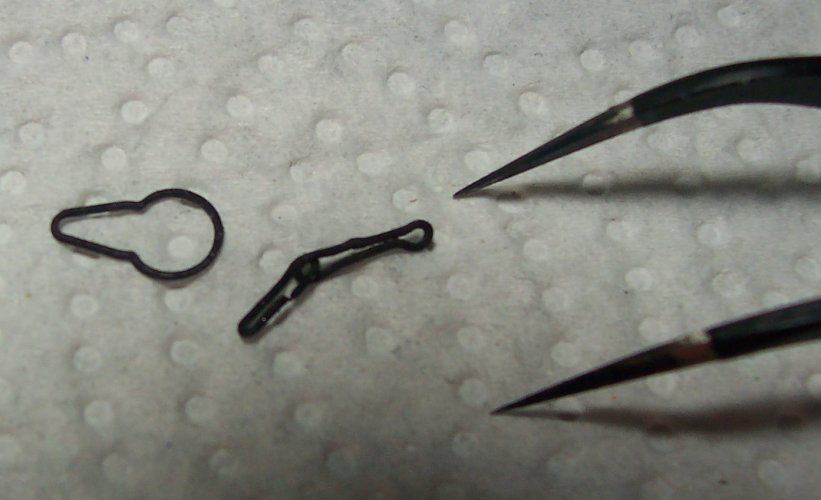
There are lanyards that need to be made from the deadeyes that must be spaced apart correctly. I found this tool online that seems to work pretty good but I did have to make a few modifications to get it to work for this ship.
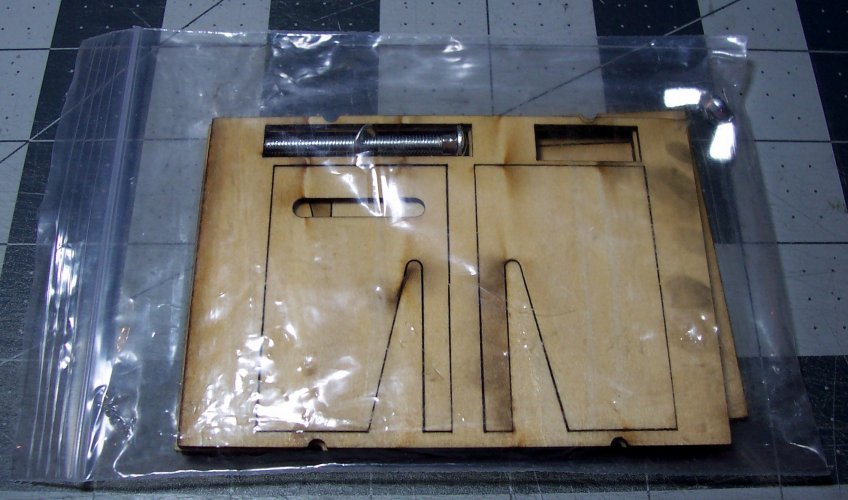
This is like a mini-sub project on its own.

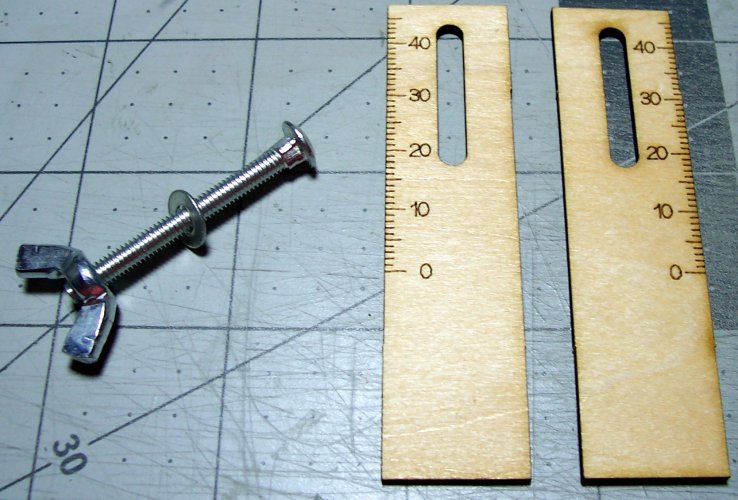
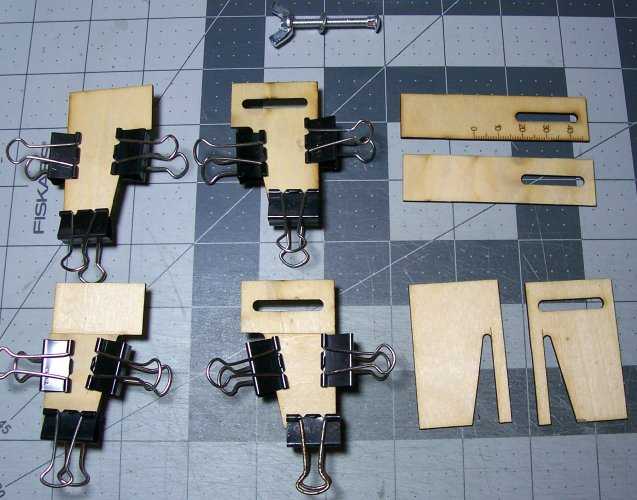
This is how its used to make the lanyards. This one was just an experiment and I eventually substitute a thinner scale rope. I also discovered a way of using the tool together with the brass etch strop.
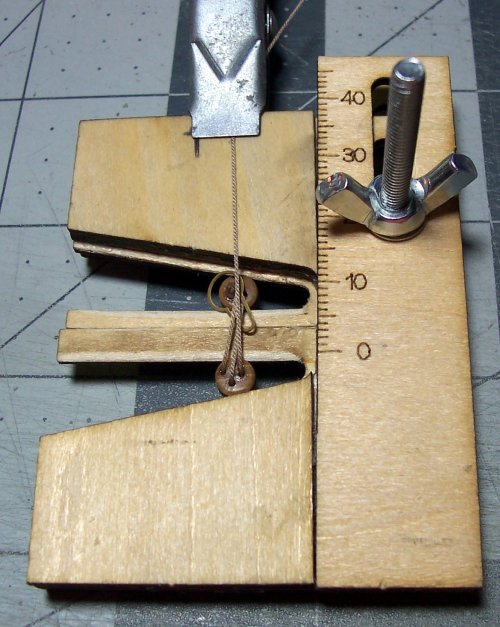
This stuff is essential for some of the rigging. Its just plane easier to have an instant bond in some places. It also flows really fantastic into the paper and card making a very strong part.
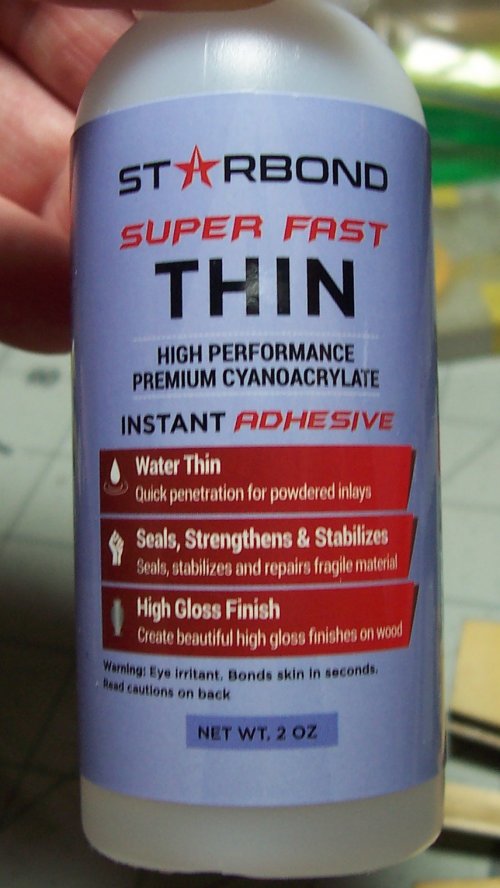
Here is one of the completed experimental lanyards.
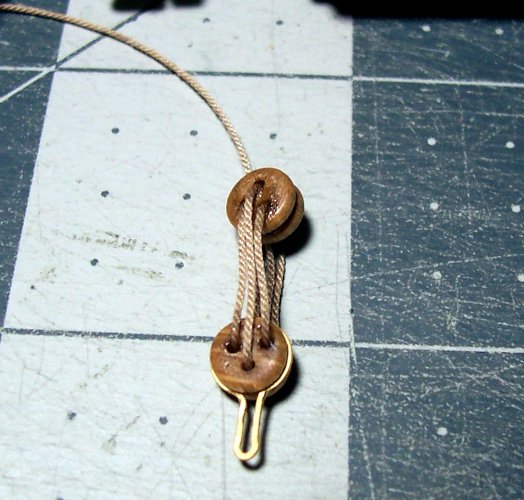
Another experiment. This time its the shrouds. They are added a pair on the starboard side first. Then port, then starboard and so on. The shrouds themselves are standing rigging so they are dark brown in color (0.76 mm) to give the appearance that they have been coated in tar.
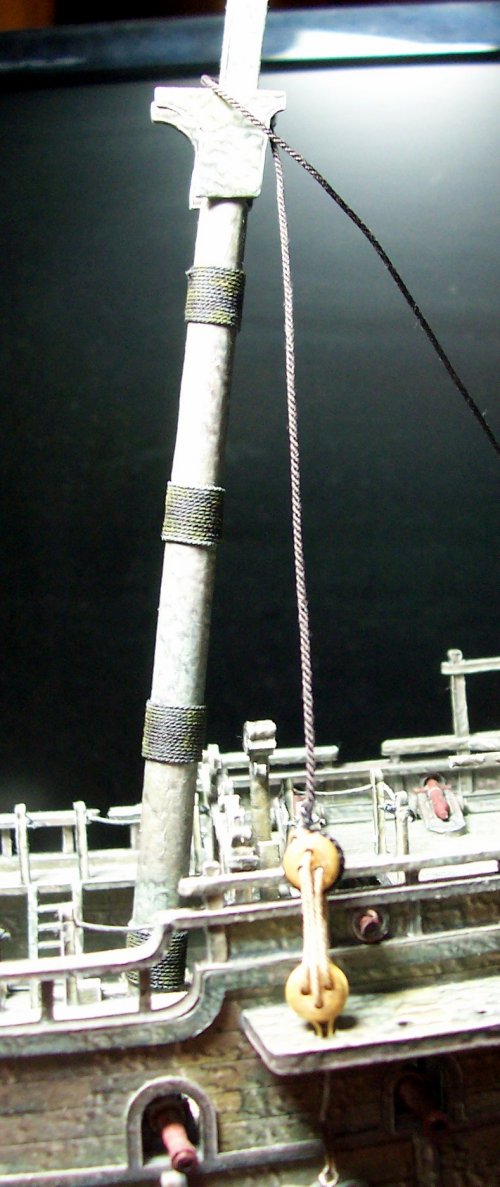
I feel the scale rope used for the lanyards is to thick as can be seen below.

This picture shows detail of using small black nails to affix the chain plates to the side of the hull per the plan.
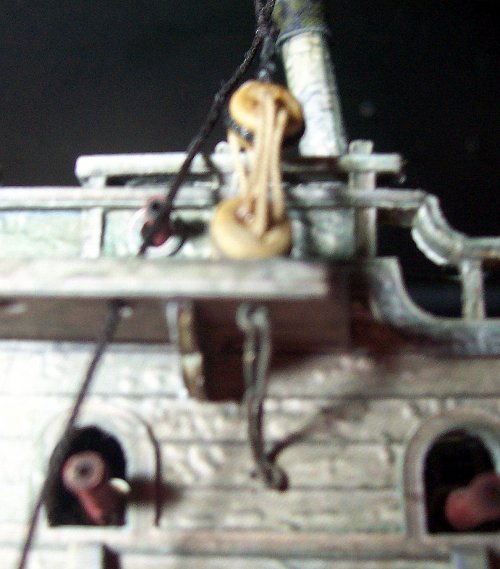
It's kind of hard to know how much tension to put on the shrouds? Too tight and they will pull the mast out of true. Too loose, and the shrouds will be floppy and nasty
 I just gave a gentle tension. You can get a feel for it. I took the alligator clips off my multi-meter temporarily to hold the rigging at the correct tension. I then ran a tiny amount of CA glue onto the rope, and the dead-eye to "pinch" it into place. Just make sure the clip(s) don't slip before you glue it
I just gave a gentle tension. You can get a feel for it. I took the alligator clips off my multi-meter temporarily to hold the rigging at the correct tension. I then ran a tiny amount of CA glue onto the rope, and the dead-eye to "pinch" it into place. Just make sure the clip(s) don't slip before you glue it 
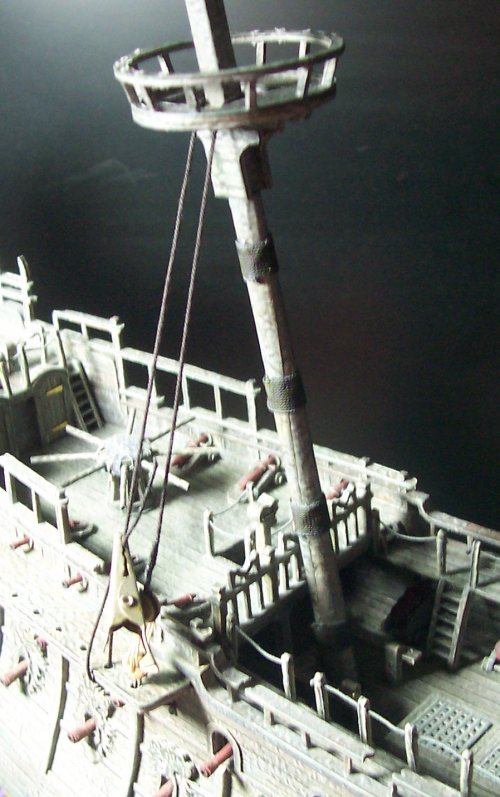
I remade them with the thinner scale rope for the lanyards. That looks much better to me scale wise.
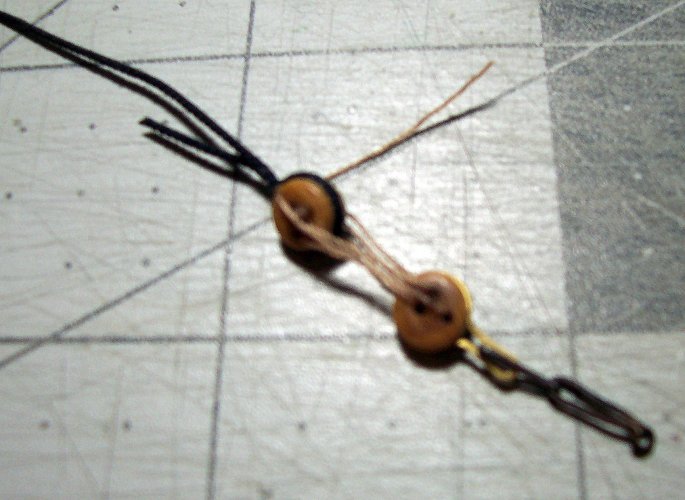
You need to solder the joint in the links to make sure they don't pull apart. I found this pointed soldering iron tip was mazing for the job! I love it
 Make sure to clean off the flux residue afterwards with a tiny wire brush.
Make sure to clean off the flux residue afterwards with a tiny wire brush.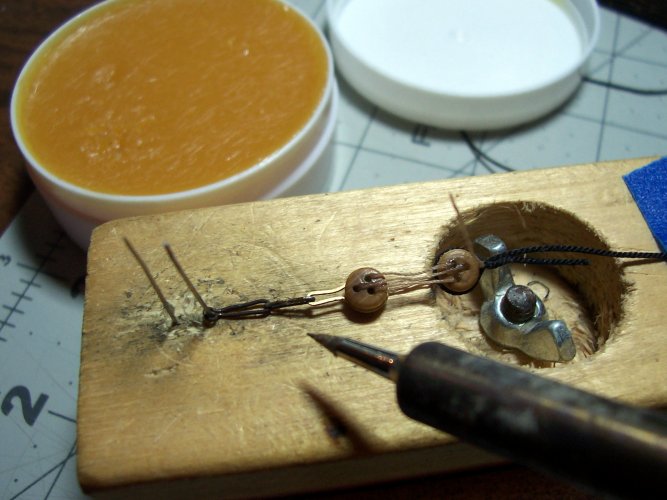
Still the shrouds need some thought. I don't like them so far,
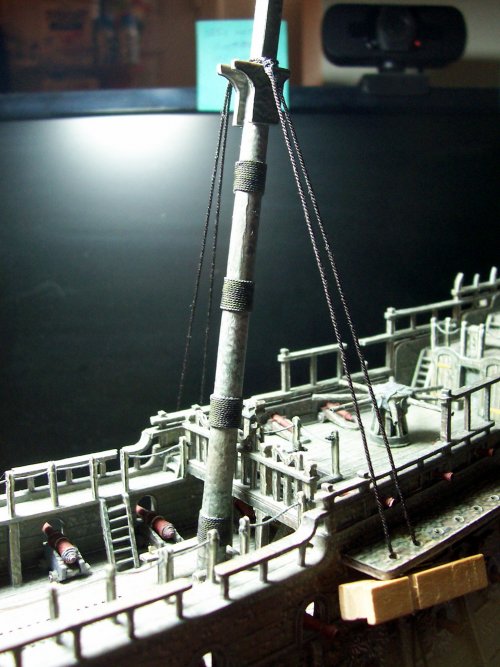
- Apr 5, 2013
- 13,876
- 10,215
- 228
Wow!! Lots of progress!! Check Craigslist for an Aquarium. I have given away aquariums that would hold that model for free. Think of the diorama you could make, and be protecting the model too. People give away a lot for free, show them what you are using it for, they'll probably clean it for you. 
Shrouds, Seizing's, Deadeyes, Strops and Chain plates for the Lower Mainmast
Seizing's go around a rope for security and to hold the ropes or strands of rope together as one
 That is something else that is needed for the model. I found the thinnest line was some conventional thread used for repairs or dressmaking (raided my wife's sewing box). You don't need to worry about sagging of the thread as this is just used as a whip or wrapping.
That is something else that is needed for the model. I found the thinnest line was some conventional thread used for repairs or dressmaking (raided my wife's sewing box). You don't need to worry about sagging of the thread as this is just used as a whip or wrapping.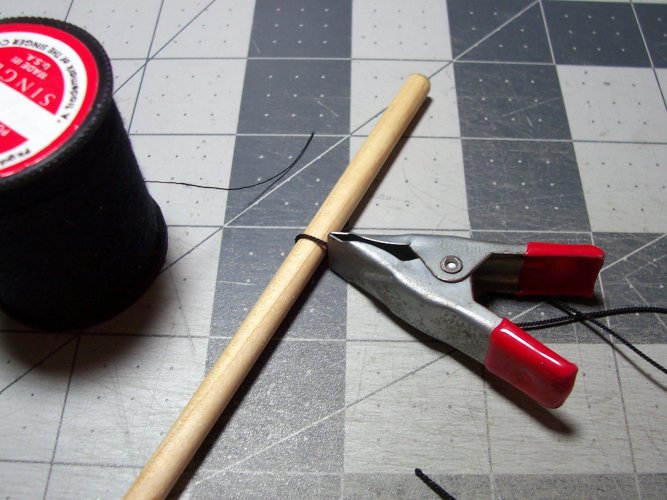
Here's one of the ends of a shroud that will loop over the mast head for the lower mainmast.
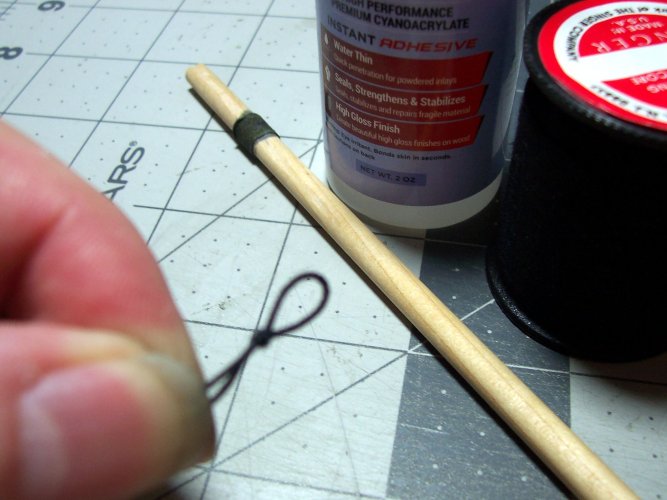
Here is the actual seizing in progress. I found that a metal clamp is needed to hold the two ends of the rope together while I tie the seizing around. Its a bit fiddly, so its just a matter of trying to get a hold on it all so you can get the whipping / seizing in place. I found that about 8" of thread for each seizing worked pretty good.
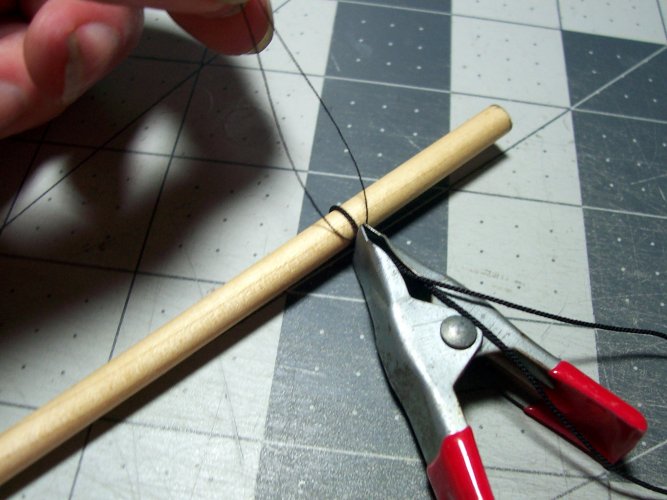
Here I installed the shrouds for the lower mainmast to see what they would look like, and to get familiar with them.
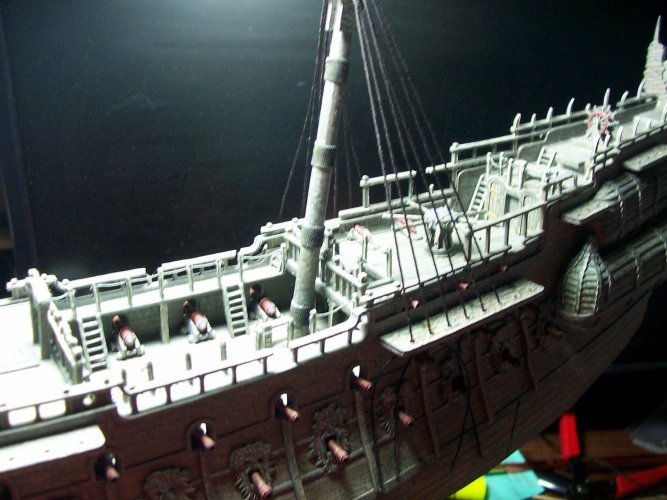
Here's a closeup of the way the shrouds lay upon each other as they are alternately stacked from starboard to port sides. I have a picture lower down this thread that shows how it should be. Its basically the same as a full-size ship.
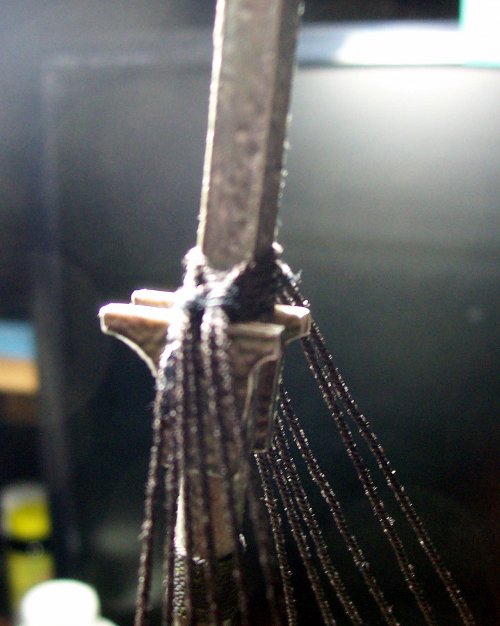
Now to finish building the rest of the lanyards for the lower mainmast shrouds. This tool I got works nice
 I found it works for the 3mm, 4mm, and 5mm deadeyes beautifully. Its set to its lowest setting for this ship, although it will open up if required for other ships. This is the distance between the deadeyes. This is with the thinner rope 0.20mm. These have to be adjusted on the real ship so they can't be coated in tar so the rope is natural tan color.
I found it works for the 3mm, 4mm, and 5mm deadeyes beautifully. Its set to its lowest setting for this ship, although it will open up if required for other ships. This is the distance between the deadeyes. This is with the thinner rope 0.20mm. These have to be adjusted on the real ship so they can't be coated in tar so the rope is natural tan color.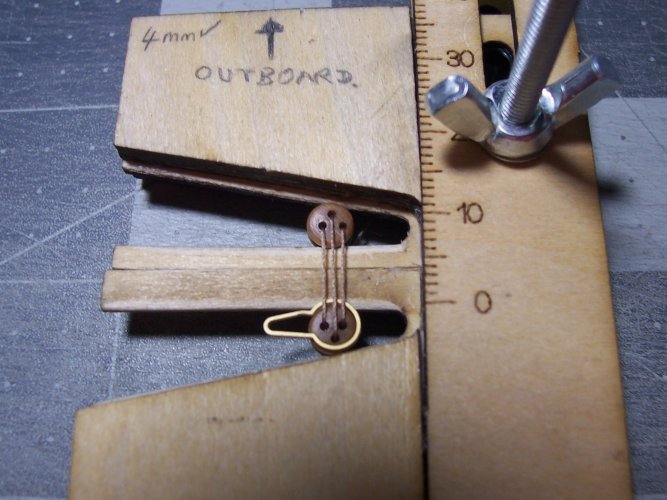
Note that the lanyards are rigged differently on the port and starboard sides, as well as for how the rope has been made (right or left hand).
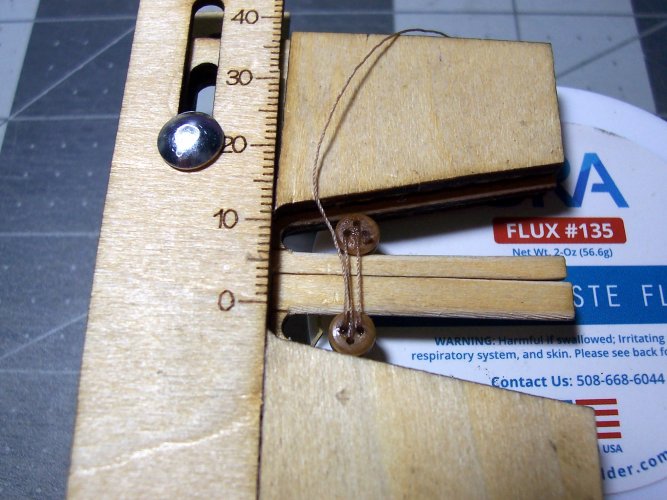
This one is ready for installation.
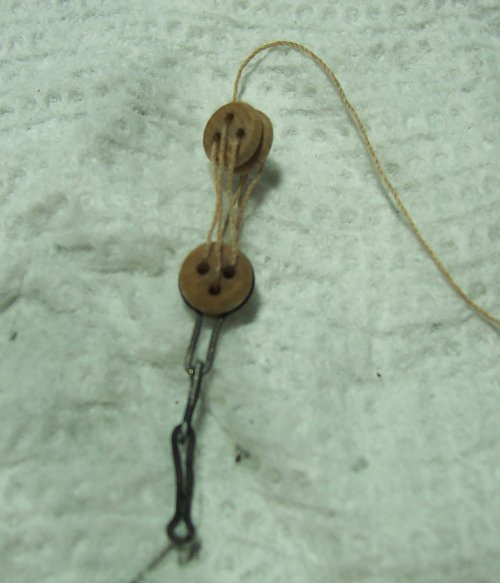
I found that the acid doesn't affect the other parts of the lanyard so it can all be dunked in the black patina liquid together

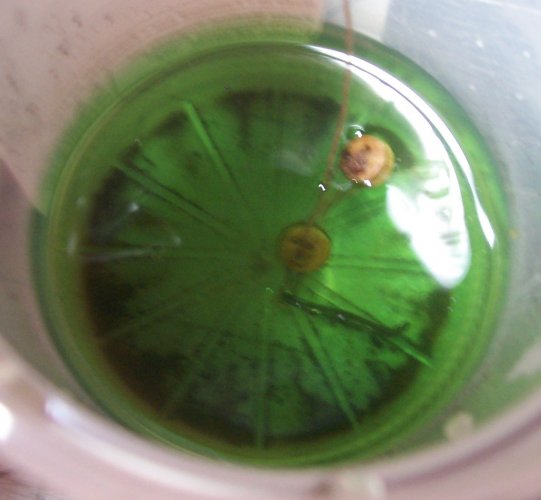
Another view of a shroud being clamped for being seized.
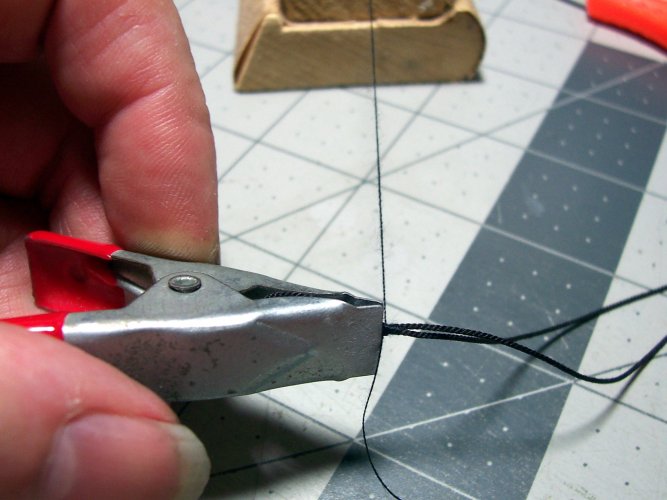
Before the shrouds are tensioned, it is best to install the mainstay so it prevents the mast from being pulled out of true. That would not be good

 This is 1.5mm so its very strong!
This is 1.5mm so its very strong!An important point I found is to avoid gluing as much as possible which includes the masts, caps, tops, and shrouds. They really do not need to be glued as the rigging hold everything in place. It allows the caps to be removed to drop on the shroud loops and so on. It also allows for maintenance if needed later on down the line say if one of the masts got busted
 The masts were never fixed on full size ships either I found out. They were not nailed or glued in place relying only on the weight of the masts, and supports from the ship to hold it.
The masts were never fixed on full size ships either I found out. They were not nailed or glued in place relying only on the weight of the masts, and supports from the ship to hold it.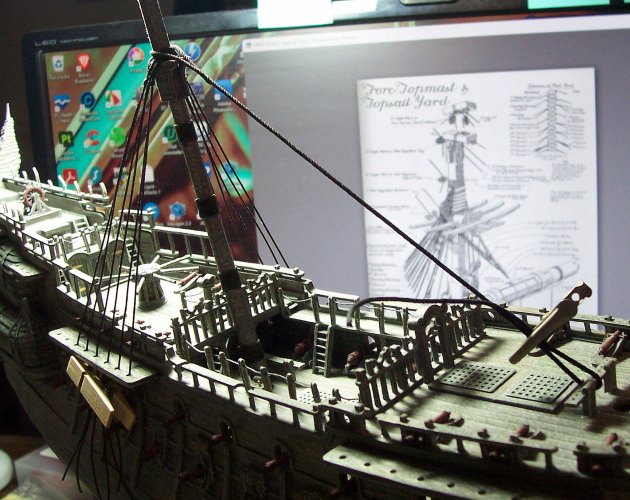
So, the tops can be popped on and off as needed not requiring to be glued in place. It is essential to build as many assemblies off the ship as it is so much easier to do. Ideally, you should just be able to drop the parts in place with the least amount of worry for the rigging as possible. Otherwise too, it is easy to paint yourself into a corner if you don't.
The lanyards that go to the tops are a bit smaller at only 3mm in diameter as can be seen below.
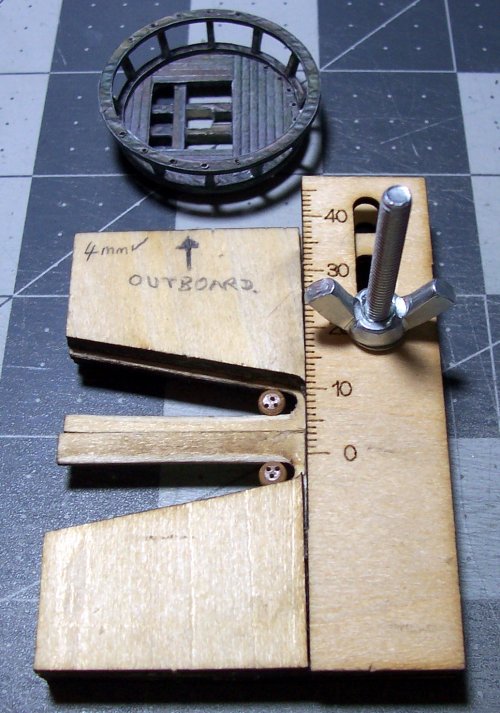
These smaller lanyards all sit on the rail of the top. A different style of strop is needed for these and there is no word of this on the plans unfortunately.
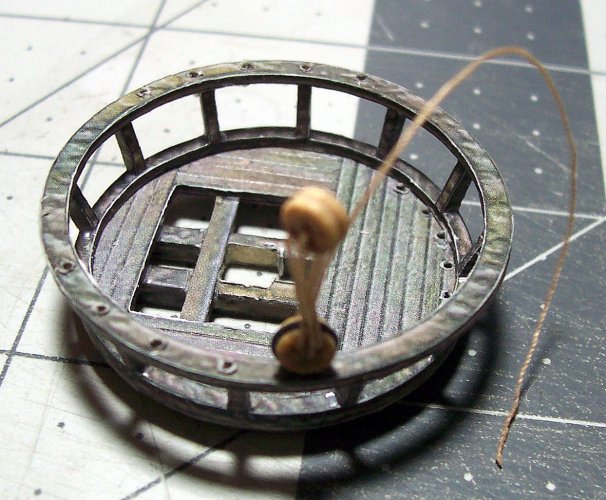
The CA glue holds the lanyard in its shape when it pops off the jig.
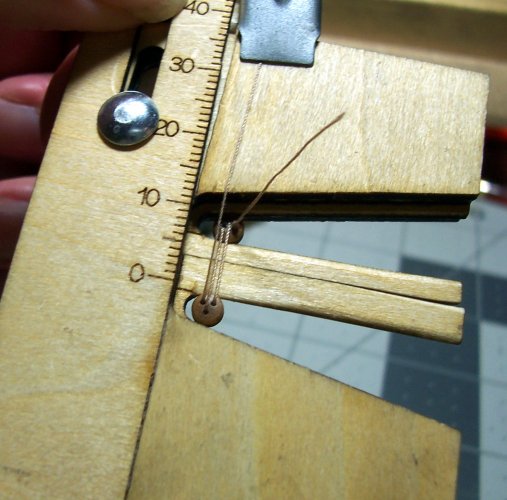
Here I am making one of the strops needed for these lanyards. it is basically 26 gauge garden wire. They also need to be dipped in the black patina eventually before being installed on the top.
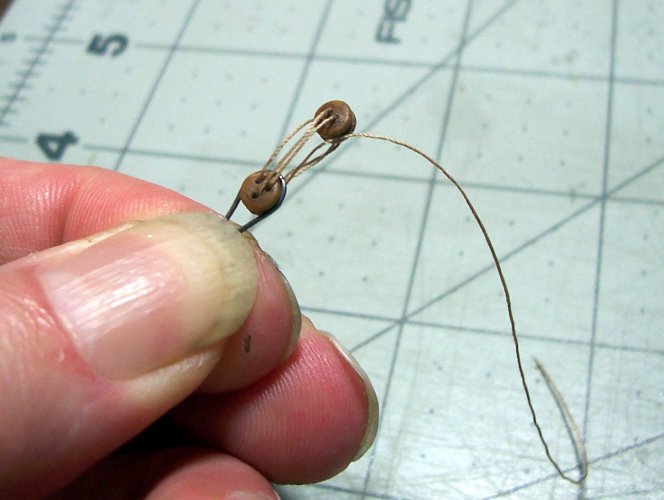
This shows how the lanyards should be rigged.
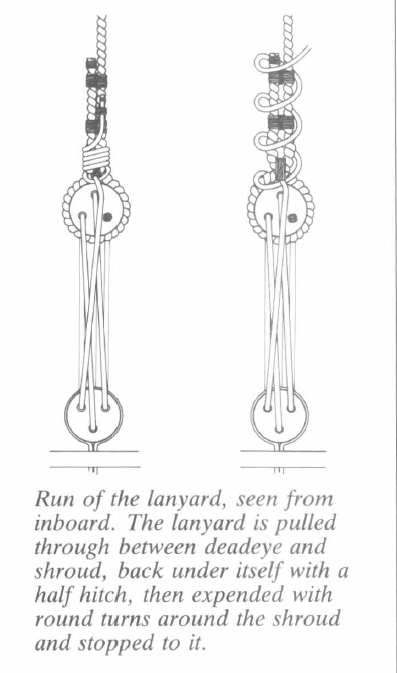
This is for an English ship and we are building a Dutch but there are some similarities, plus its a totally cool picture

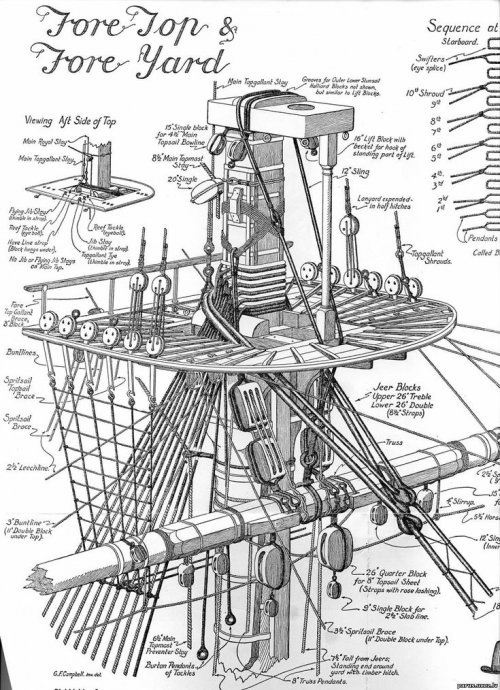
The order of the shrouds after the top has been slipped into place.
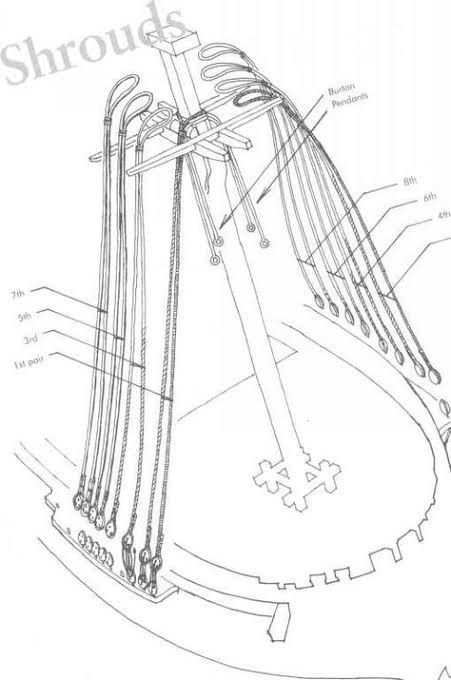
Its always useful to have a look to see how they are on a real ship.
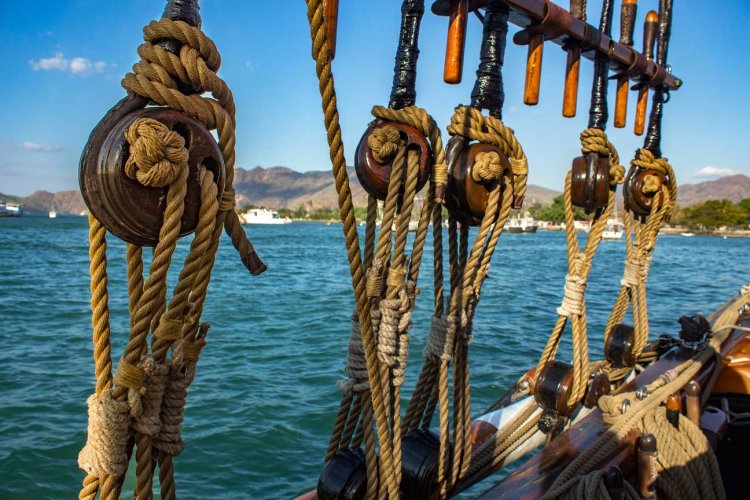
Another look at rigging lanyards I found online.
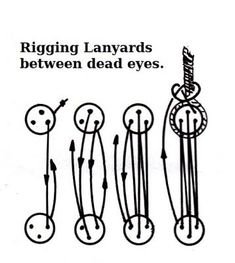
Absolutely amazing detail.
I missed my chance to do the "Chiefs cruise" on the USS Constitution. I was made Chief at sea, and my tour didn't end until after the signing for the "Chiefs cruise" ended. I would have loved to get the training and put to sea on "Old Iron Sides", but missed it.
I missed my chance to do the "Chiefs cruise" on the USS Constitution. I was made Chief at sea, and my tour didn't end until after the signing for the "Chiefs cruise" ended. I would have loved to get the training and put to sea on "Old Iron Sides", but missed it.

